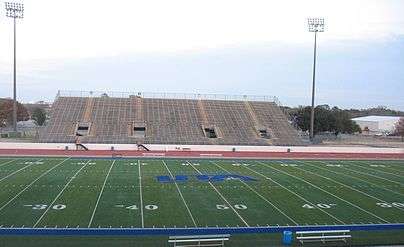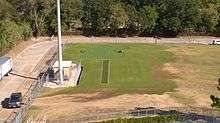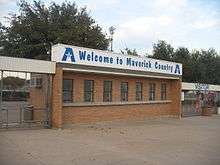Maverick Stadium
| (The Mav) | |
 Maverick Stadium press box and suites | |
| Location | Arlington, Texas |
|---|---|
| Coordinates | 32°43′45.14″N 97°7′34.90″W / 32.7292056°N 97.1263611°WCoordinates: 32°43′45.14″N 97°7′34.90″W / 32.7292056°N 97.1263611°W |
| Owner | University of Texas at Arlington |
| Operator | University of Texas at Arlington Athletic Department |
| Capacity | 12,500 |
| Record attendance | 18,033 vs. North Texas September 6, 1980 |
| Surface | FieldTurf |
| Construction | |
| Built | 1979–1980 |
| Opened | September 6, 1980 |
| Renovated | Playing surface and track 2009, locker rooms 2011, PA 2012 |
| Construction cost | $7 million |
| General contractor | Walker Construction Co. |
| Tenants | |
| University of Texas at Arlington Track and Field, Arlington Independent School District football | |
| Website | |
|
www | |
Maverick Stadium is a 12,500-seat multi-purpose stadium on the western edge of University of Texas at Arlington campus.
It hosts the university's track and field teams and is also leased by the Arlington Independent School District and Pantego Christian Academy for their football teams. It usually serves as the site of 1-3 high school football playoff games every year.
The stadium previously served as UTA's home football stadium until the university dropped its program after the final game of the 1985 season.
The stadium can host football and soccer games, track and field meets, as well as many varied festivals and special events, including the annual Texas Scottish Festival and Highland Games, Special Olympics and Bed Races, an annual UTA tradition in the fall.[1][2]
Features

Maverick Stadium is composed of five major components, the playing field and track, west (home) stands, east (visitor) stands, the press box above the west stands and the locker rooms and support space underneath the west stands. The Gilstrap Athletic Center is a stand-alone building directly adjacent to the locker room section, directly north of the west stands. It had housed the entire UTA Athletic Offices, until College Park Center was built in 2012 and most of the Athletic Department moved to the new arena. It does connect to both the locker room and playing field.
The playing surface consists of FieldTurf artificial playing field and can be easily configured for soccer or football games. The field is circled by a 400-meter Polytan USA track surface.
The west stands have a seating capacity of approximately 8,000, of which 1,831 are chair-back seats in the center section. The east can sit approximately 4,500. Architectural plans were designed for eventual capacity to reach 26,000 by expanding both ends of each section from its current terminus at the 15-yard lines to just past the end zones.
Underneath the west stands are the locker rooms, medical and training facilities, a full-sized, 3,700 square foot weight room,[3] equipment storage and other support functions. A reception room for formal events is also located in this area and can be accessed through the west entrance.

The press box is a three-story structure. The first level is an outdoor film deck while the top two contain space for radio and television broadcasts, print media, coach booths and suites. The press box has a 168-person capacity.
There are five light poles in the stadium, four of which flood the field and the other on the field event venues on the northern side of the stadium. They are a mercury vapor with a total lighting capacity of 90 foot candles.
Fans primarily enter Maverick Stadium from the south, where a seven-window ticket booth faces out onto a 689-space parking lot. The home entrance is to the west of the booth, while the visitors entrance is to the east. There is also a seven-window ticket booth and entrance on the east side of the stadium directly behind the east stands.
Facilities for steeplechase and all field events are provided within the stadium. Javelin, shotput, and discuss areas are located north of the track and playing field, while the long jump, triple jump and pole vault pits are just south. The high jump area is between the field and track on the north end of Maverick Stadium.
There's a large, open grass field on the north side as well that had served as the practice field for the football team.
Renovations
In recent years, Maverick Stadium has undergone many renovations to increase the amenities for the athletes and spectators in order to keep it a desirable place to hold athletic contests and special events.
In 2009, the older artificial turf was replaced with FieldTurf.[4] The track was replaced around the same time with a Polytan USA track surface.[5] It is a standard Olympic 400-meter track with various other field event capabilities.

The locker rooms received their first renovation since construction over the winter break between the fall 2010 and spring 2011 semesters. These included wood-finish lockers replacing the original metal lockers, new paint, fresh carpeting and partitioning of the main locker room between the baseball, softball and men's and women's track and field teams.[6] The University recently constructed clubhouses at Clay Gould Ballpark for the baseball team and Allan Saxe Field for the softball squad, so they no longer have to use Maverick Stadium's facilities and offices.[7] This leaves the University's track and field teams as the only full-time tenants in Maverick Stadium's locker rooms.
In the fall 2012, the original public address system installed during the original construction was completely replaced with a new system, providing a clearer sound throughout the stadium.[8]
In fall 2015, the University added a putting green for the UTA golf team in the northwest corner of Maverick Stadium. Another light pole was added to help illuminate that portion of the field. The addition coincided with the announcement that the University would add women's golf to the sport offerings at UTA.
History
| Date | Opponent | Attendance | Result |
|---|---|---|---|
| September 6, 1980 | North Texas | 18,033 | 14-31 |
| October 9, 1982 | North Texas | 9,487 | 3-17 |
| September 8, 1984 | West Texas A&M | 9,367 | 27-19 |
| September 22, 1984 | Texas State | 9,048 | 48-13 |
| October 6, 1984 | Stephen F. Austin State | 8,894 | 21-27 |
| September 11, 1982 | Sam Houston State | 8,519 | 63-10 |
| October 27, 1984 | Arkansas State^ | 8,276 | 21-51 |
| October 2, 1982 | Louisiana Tech | 8,149 | 14-17 |
| November 21, 1981 | Lamar* | 8,000 | 31-7 |
| September 17, 1983 | Louisiana-Monroe | 7,338 | 10-16 |
| ^ Homecoming * Clinched SLC championship |

When UTA began playing football as a four-year institution in 1959, they played their games in Memorial Stadium. The on-campus venue, coupled with successful football seasons, consistently saw the Stadium at or over the 10,022 capacity. After the 1969 season, UTA would leave Memorial Stadium, though local high school teams would stay play there for several more years. The venue was demolished in the winter of 1973 to make way for the current Maverick Activities Center.
UTA averaged around 9,000 in attendance from 1966-69. However, the University viewed Memorial Stadium as small and outdated. UTA was planning a move to the University level, the highest level of college football at that time, and decided they needed to play in a bigger venue to encourage higher-level teams to play in Arlington. This was needed to move up as the NCAA required half the schedule be against University level competition. Along with the urging of Arlington City Hall, who just bought Turnpike Stadium from Tarrant County, the Mavericks began playing their home games at a multi-purpose, off-campus stadium built primarily for baseball, though it could be converted for football use, in 1970.
When the Washington Senators moved from Washington D.C. to Arlington and changed their name to the Texas Rangers, they became the primary tenants of the stadium. This created conflicts between the franchise and the University. One notable example was when the Rangers exercised a clause giving them control over the stadium 24 hours before and after home games. UTA had to play their 1974 home opener at the Cotton Bowl in Dallas, about 25 miles away from campus. UTA would occasionally have to play in other venues as well, such as Cravens Field, a facility in North Arlington that is owned and operated by the Arlington ISD.
Finally, after renovations were announced that the now-renamed Arlington Stadium would become a permanent baseball facility, the UTA football team eventually moved their home games to Cravens Field from 1977 to 1979. UTA's all-time home record at Arlington Stadium was a measly 11-18, a winning percentage of .379 (compared to .670 at Memorial Stadium), while they were 8-6 at Cravens.
The UTA Athletic Department knew that Turnpike Stadium and Cravens Field weren't long-term homes. They were working on a way to move the UTA football program into their own facility on campus. Preliminary approval for Maverick Stadium was issued by the UT System Board of Regents in November 1977. This cleared the way for planning to begin and the Regents approved the final plans in October 1978. After bids were approved later that year, construction began early in 1979 on the site of the football practice fields on the west side of campus.
| Season | Average | High |
|---|---|---|
| 1980 | 8,062 | 18,033 |
| 1981 | 5,888 | 8,000 |
| 1982 | 7,588 | 9,487 |
| 1983 | 5,554 | 7,338 |
| 1984 | 7,496 | 9,367 |
| 1985 | 5,600 | 7,205 |
After more than a decade, the first on-campus football game was played as the University of North Texas opened the venue in front of a record crowd of 18,033, an eventual 31-14 loss for UTA. It also was the first ESPN college football broadcast, as the fledgling network had just began operations.[9] Due to the NCAA's television contract, the game couldn't be shown live and was a tape-delayed broadcast.
The Mavericks would finish out their inaugural year at Maverick Stadium with a 1-5 home record, winning their final game against Arkansas State in front a crowd of 4,691. Despite the record attendance of the first game, Maverick Stadium averaged 8,062 fans per home game the first year.

The team would do a better job defending their home turf in the following years as they compiled a record of 16-11 following the 1980 season, for a total Maverick Stadium home record of 17-16. In 1981, UTA went 4-1 at The Mav on their way to winning their final Southland Conference championship. It was also their last year participating at the NCAA's highest level of football, then known as Division 1-A, as the NCAA would reclassify UTA and almost the entire Southland Conference as Division 1-AA
The last home game in Maverick Stadium for UTA's football program was against Louisiana Tech on November 16, 1985. The 29-14 loss to the Bulldogs eliminated UTA from the Southland Conference championship race, the second year in a row the Bulldogs had ended UTA's championship run. The final game at the stadium was attended by 4,800 fans, the smallest of the year. UTA would finish 3-2 at home in 1985.
There have been recent discussion's within the university about reviving the Maverick football program. Maverick Stadium would need major renovations to become a modern-day FBS college football stadium, adding another factor in the university's decision on the program's return. There is speculation of even foregoing Maverick Stadium and playing off campus.
Maverick Stadium is considered one of the finest track and field venues in the Southwest and served as the site for the Southland Conference outdoor track meet in 1981, 1986, 1992, 2001, 2002, 2006 and 2010 and also the 2013 Western Athletic Conference meet.
The men have won eight team conference championships and five runners-up since the stadium opened, along with 23 event All-Americans. They only won one meet at Maverick Stadium, in 1992. The women have won six team titles, seven runners-up and ten All-Americans. The 2001 meet was the only Southland championship the women's team won on their home track.[10]
Collegiate stadium records, single game
| Record description | Record | Record holder(s) | Date | Opponent | Final Score |
|---|---|---|---|---|---|
| Rushing carries | 38 car | Shawn Faulkner^ | September 9, 1983 | Western Michigan | 14-21 |
| Rushing yards | 202 yds | Burton Murchison^ | October 19, 1985 | Lamar | 37-17 |
| Rushing touchdowns | 3 TD's | Wesley Williams^ Randy Johnson |
September 9, 1985 October 8, 1983 |
Angelo State Wichita State |
23-35 34-24 |
| Completions | 27 comp | Fred Hessen^ | November 21, 1981 | Lamar | 31-7 |
| Passing yards | 367 yds | Fred Hessen^ | November 21, 1981 | Lamar | 31-7 |
| Passing touchdowns | 3 TD's | David Bates | October 19, 1985 | Lamar | 37-17 |
| Receptions | 10 rec | Reuben Eckels^ Marvin Walker^ |
October 8, 1983 October 9, 1982 |
Wichita State North Texas |
34-24 3-17 |
| Receiving yards | 180 yds | Keith Arbon | October 19, 1985 | Lamar | 37-17 |
| Receiving touchdowns | 2 TD's | Andre Gray David Wood^ |
September 22, 1984 September 8, 1984 |
Texas State West Texas A&M |
48-13 27-19 |
| Longest field goal | 58 yds | Jeff Heath^ | November 6, 1982 | East Carolina | 24-40 |
| Longest Kickoff Return | 100 yds | Bobby Humphery^ | September 12, 1981 | New Mexico State | 26-13 |
| Most Points Scored | 63 | UTA | September 11, 1982 | Sam Houston State | 63-10 |
^ Denotes Non-UTA Player
References
- ↑ http://www.theshorthorn.com/life_and_entertainment/arts_and_entertainment/scottish-festival-to-feature-highland-games-dancing/article_1ff661ea-b1e4-11e2-8073-0019bb30f31a.html
- ↑ http://www.theshorthorn.com/news/teams-get-dressed-for-bed-races/article_cc83e084-3062-11e3-966a-001a4bcf6878.html
- ↑ http://www.utamavs.com/strength.html
- ↑ http://www.utamavs.com/genrel/072009aab.html
- ↑ http://www.prnewswire.com/news-releases/track-inspires-new-generation-at-us-area-youth-olympic-selection-trials-93593374.html
- ↑ http://www.theshorthorn.com/sports/maverick-stadium-locker-rooms-to-get-face-lift/article_c5eaa37f-84f7-5aad-97e7-bd5c59e61791.html
- ↑ http://www.utamavs.com/sports/m-basebl/spec-rel/091713aaa.html
- ↑ http://www.theshorthorn.com/news/campus/campus-may-hear-static-noise-from-maverick-stadium-sound-testing/article_9de650c8-2428-11e2-8936-0019bb30f31a.html?mode=story
- ↑ http://www.texasbob.com/stadium/stadium.php?id=274
- ↑ http://www.southland.org/Conference/Publications.aspx